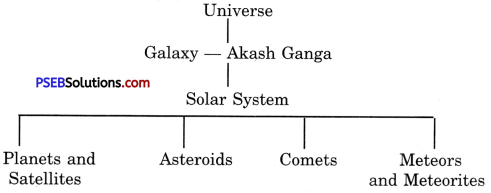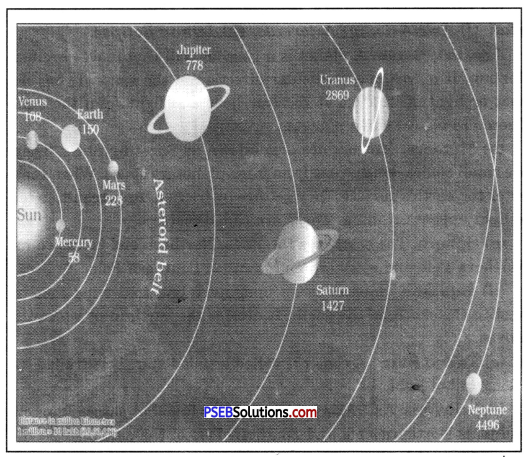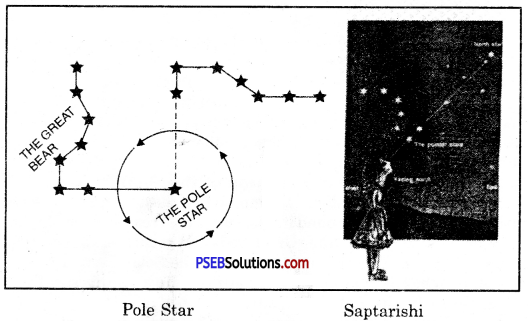Punjab State Board PSEB 6th Class Social Science Book Solutions Geography Chapter 1 Earth – As a Member of Solar System Textbook Exercise Questions and Answers.
PSEB Solutions for Class 6 Social Science Geography Chapter 1 Earth – As a Member of Solar System
SST Guide for Class 6 PSEB Earth – As a Member of Solar System Textbook Questions and Answers
I. Answer the following questions in brief :
Question 1.
What do you mean by the Universe? Enlist the different forms of the Universe.
Answer:
The Universe is a vast and infinite space having millions of galaxies.
Composition of Universe

It consists of the sun, the planets, the earth, the moon, stars, dust particles, gases, etc. It is so large that one can’t estimate its size.
Forms of the Universe.The galaxy, milky way, planets, satellites, asteroids, comets, meteors and meteorites are the different forms of the Universe.
Question 2.
What is a planet? Is our earth a planet? How?
Answer:
A planet is a celestial (heavenly) body which draws heat and light from the sun and also revolves around it.The word ‘planet’ comes from the Greek word ‘planetai’ which means wanderer (moving thing). Planets are opaque bodies and reflect the Sun’s light.
Yes, our earth is a planet. It gets heat and light from the sun and moves around it in a particular direction in the space. There are eight planets.
![]()
Question 3.
What do you understand by Solar System?
Answer:
The sun and, the eight planets which revolve around it make up the Solar System. In addition to the eight planets, there are 63 satellites in the Solar System. The Solar System is also known as the Family of the Sun. The sun is the centre of solar system. Sol in Roman mythology means Sun God.

The eight planets in the order of their distance from the Sun.
Question 4.
Enlist the distance of planets from the sun. Also tell which planet is far away and which is nearest.
Answer:
There are eight planets. As per their distance from the sun, they are :
- Mercury,
- Venus,
- Earth,
- Mars,
- Jupiter,
- Saturn,
- Uranus,
- Neptune.
Of these planets, Neptune is the farthest and Mercury is the nearest.
Question 5.
Enlist planets according to the size of planets.
Answer:
In ascending order, the sizes of planets are as follows :
- Mercury,
- Mars,
- Venus,
- Earth,
- Neptune,
- Uranus,
- Saturn,
- Jupiter.
Question 6.
Which facts do you know that tell us the shape and size of the earth?
Answer:
- Shape of the Earth: The earth is not flat, it is round in shape. It is like a very big ball.
- Size of the Earth: As far as size of the earth is concerned, it ranks fifth among the planets. It is smaller than Jupiter and Saturn. Its diameter is 12,756 km. Its circumference is 40,000 km. On poles its diameter is 12,712 km. It means that its diameter on the poles is lesser by 44 km than the equator.
![]()
Question 7.
Write notes on the following :
(а) Planet
Answer:
Planet: A planet is a gaseous ball that moves around the sun. It moves in a particular direction in the space. It has no heat or light of its own. It receives heat and light from the sun. There are eight known planets.
(b) Meteors
Answer:
Meteors: Meteors are also known as Shooting Stars. They are small bodies which come from inter-planetary space. When they enter the earth’s surface, they get fire by friction. As a result, a lot of light appears trailing,. These are called meteors.
(c) Sphere
Answer:
Sphere: The earth has two ends. Northern end is known as Northern Pole and southern end is called Southern Pole.
(d) Equator
Answer:
Equator: Equator is an imaginary line that runs east to west in the centre of the earth. It divides the earth into two equal halves.
(e) Tailed Star
Answer:
Tailed Star: A comet is called a tailed star. It is trailed by a long tail of light.
(f) Axle/Axis
Answer:
Axle/Axis: Axle/Axis is an imaginary line that passes through and joins Northern Pole and Southern Pole of the earth.
(g) Asteroids
Answer:
Asteroids: Asteroids are small planets which revolve around the sun. They lie between the orbits of Mars and Jupiter.
(h) Lunar Eclipse.
Answer:
Lunar Eclipse: The earth revolves around the sun and the moon moves around the earth. During their revolution, when the earth comes between the sun and the moon, it casts its shadow on the moon. It is called Lunar Eclipse.
II. Fill in the blanks in the following :
Question 1.
Our earth is a flat sphere, therefore it is called ____________
Answer:
an oblate spheroid
Question 2.
The circumference of the earth is ____________ km.
Answer:
40,000
Question 3.
The diameter of earth on equator is ____________ km and diameter of earth at poles is km.
Answer:
12,756, 12,712.
III. Activity (Something To Do)
Question 1.
Show the planets according to the distance from the Sun.
Answer:

| S.No. Planet | Distance from the Sun (million kms) |
| 1. Mercury | 58 (The nearest) |
| 2. Venus | 108 |
| 3. Earth | 150 |
| 4. Mars | 226 |
| 5. Jupiter | 778 |
| 6. Saturn | 1427 |
| 7. Uranus | 2870 |
| 8. Neptune | 4496 (The farthest) |
![]()
Question 2.
Enlist the planets according to their size.
Answer:
| S. No. Planet | Size |
| 1. Jupiter | 1st (The largest) |
| 2. Saturn | 2nd |
| 3. Uranus | 3rd |
| 4. Neptune | 4th |
| 5. Earth | 5th |
| 6. Venus | 6th |
| 7. Mars | 7th |
| 8. Mercury | 8th (The smallest) |
PSEB 6th Class Social Science Guide Earth – As a Member of Solar System Important Questions and Answers
Multiple Choice Questions :
Question 1.
Which is the nearest planet to the sun?
(A) Neptune
(B) Mars
(C) Mercury
(D) Earth.
Answer:
(C) Mercury.
Question 2.
The tilting of earth is responsible for :
(A) Change of the days
(B) Change of the sunrays
(C) Change of the seasons
(D) None of these.
Answer:
(C) Change of the seasons.
Question 3.
Stars appear to move from :
(A) West to East
(B) East to West.
(C) North to South
(D) South to West
Answer:
(B) East to West.
![]()
Question 4.
What are the tiny bodies between the orbit of Mars and Jupiter called?
(A) Asteroids
(B) Comets
(C) Meteor
(D) Meleorities
Answer:
(A) Asteroids.
Question 5.
Which is the largest planet in solar system?
(A) Mercury
(B) Mars
(C) Jupiter
(D) Saturn.
Answer:
(C) Jupiter.
Fill in the Blanks :
Question 1.
____________ planet appears to be yellowish.
Answer:
Saturn
Question 2.
____________ study the space and travel.
Answer:
Astronauts
Question 3.
Group of shining stars is called ____________
Answer:
Constellation
Question 4.
____________ is a group of seven stars.
Answer:
Saptarishi
Question 5.
____________ is called a tailed star.
Answer:
A comet.
True/False :
Question 1.
There are 7 planets in our solar system.
Answer:
False
Question 2.
The universe includes the sun, satellites, planets, stars etc.
Answer:
True.
Question 3.
Geoid means sunlike shape.
Answer:
False
Question 4.
Moon is a natural satellite of the earth.
Answer:
True.
![]()
Question 5.
The earth has a circumference of 40000 km.
Answer:
True.
Very Short Answer Type Questions
Question 1.
What do you mean by Geoid?
Answer:
Geoid means earth like shape.
Question 2.
Who are astronauts?
Answer:
Astronauts are the persons who study the space and travel in the space. Kalpna Chawla was an astronaut of Indian origin.
Question 3.
Why does the sun appear big to us?
Answer:
The sun appears big to us because it is nearest to the earth.
Question 4.
What do you understand by constellation?
Answer:
A group of shining stars is called constellation.
Question 5.
What is Saptarishi?
Answer:
Saptarishi is a group of seven stars, which appears like a Great Bear.
Question 6.
Which planets rotate in a different direction than our earth?
Answer:
Venus and Uranus rotate in a different direction than our earth.
Question 7.
What is the name of the star nearest to earth?
Answer:
The sun is the star nearest to earth.
![]()
Question 8.
How much time does the light of the sun take to reach the earth?
Answer:
It takes eight minutes to reach the earth.
Question 9.
What is the distance between the sun and the earth?
Answer:
The distance between the sun and the earth is 15 crore kms.
Question 10.
What is Akash Ganga or Milky Way?
Answer:
Akash Ganga or Milky Way is a part of galaxy consisting of a million of stars and planets.

Question 11.
Name the largest and the smallest planets.
Answer:
Jupiter is the largest and Neptune is the smallest planet.
Question 12.
Name the planets which have no satellites.
Answer:
Mercury and Venus.
Question 13.
How much time does the moon take to complete one cycle around the earth and its own axis?
Answer:
27 days and 7 hours.
![]()
Question 14.
After whose name has the Comet Halley been named?
Answer:
Comet Halley has been named after the astronomer of England ‘Almond Halley’.
Question 15.
What are spheroids?
Answer:
The spheres of the earth which are flat on the top and bottom are called spheroids.
Question 16.
Name the four planets which are bigger than the earth.
Answer:
Jupiter, Saturn, Uranus and Neptune.
Short Answer Type Questions
Question 1.
Why is the earth called a blue planet?
Answer:
Astronauts, who have seen the earth from space, say that the earth appears blue in colour. It is due to the presence of water. Therefore, the earth is called a blue planet.
Question 2.
What is the distance of the earth from sun and from the moon?
Answer:
- Earth from sun-1,50 million kms.
- Earth from moon-3,84,400 kms.
Thus the distance of earth from the sun is about 40 times more than that from the moon.
![]()
Question 3.
Why do we see only one side of the moon?
Answer:
The moon revolves around the earth in 27 days and 7 hours.
It takes exactly the same time in completing one rotation about its axis. As such, we see only one side of the moon while the other side always remains away from us.
Question 4.
Describe the composition of the Solar System.
Answer:
The Solar System is composed of the sun and the eight planets which revolve around it. The sun is the creator of the planets.
The planets are named after Greek gods and goddesses. In addition, there are in all 63 satellites or moons in the Solar System.
Question 5.
What is meant by a satellite? How many satellites are there in the Solar System?
Answer:
The word ‘satellite’ means a smaller companion to anything.
There are 63 satellites in the Solar System. The satellites revolve j around their planets and also follow them in their revolution around the sun. For example, the moon is the satellite of the earth which moves around the earth and also around the sun along with the earth.
Question 6.
Tell the main physical conditions prevalent on the moon.
Answer:
The moon has rugged and barren surface. There is no air or water on the moon. It is very hot during the day and very cold during the night.
Question 7.
What are Novae?
Answer:
Novae are stars which seem to appear out of nowhere and later disappear. They are also known as new stars. Today, we know a truly new star does not appear and only a dim star suddenly brightens up.
![]()
Question 8.
Why do the stars twinkle?
Answer:
The light from the stars travels through different layers of space. Therefore, the light rays deviate from its original path. Further, these rays are not stationary but keep on moving. This leads to the twinkling effect of the stars.
Question 9.
State some characteristics of celestial bodies.
Answer:
- They are very big and hot.
- These are made up of gases.
- These have their own heat and light.
- These are numerous.
- These are very away from us and look tiny.
Question 10.
What is a Tailed Star?
Answer:
Comets are called Tailed Stars. These are clusters of gases and dust. The comet is trailed by a long tail of light. That is why it is called a Tailed Star.
Question 11.
What is Halley’s comet?
Answer:
Halle/s comet is a narrow loop-like comet. This star appears after a gap of 76 years, It last appeared in the sky in 1956.
![]()
Question 12.
What are shooting stars?
Answer:
Meteors and Meteorites are called shooting stars. When these enter the atmosphere, the matter gets fire. So these are called shooting stars. Half burnt meteors are called Meteorites. Arizona (USA) crator is formed due to falling of a meteorite.
Long Answer Type Questions
Question 1.
What is the place of the earth in the Solar System?
Answer:
The earth is the third nearest planet to the sun. It lies between Venus and Mars and is the fifth largest planet. It has an equatorial diameter of 12,756 km and a polar diameter of 12,712 km. Its circumference is 40, 000 km. It is the only planet in the Solar System where life is possible. Water and air support all forms of life on the earth.
Question 2.
What do you know about the moon?
Answer:
The moon is the only satellite of the earth. It is over one quarter size of the earth. Its diameter is 3,476 km. It is also the nearest neighbour of the earth. It is at a mean distance of 3,84,000 km centre to centre and 3,76,284 km surface to surface. Its average orbital speed is 3,680 km per hour.
The moon revolves round the earth. Its position in relation to the sun changes every day, as it reflects the light of the sun.

Various phases of the moon
Question 3.
Distinguish between a star and a planet.
Answer:
| Star | Planet |
| 1. Stars are heavenly bodies shining by their own heat and light. | 1. Planets are opaque heavenly bodies which reflect the light of the sun. |
| 2. Millions of stars, scattered in space, occur in clusters. | 2. Nine planets revolve around the sun. |
| 3. Stars emit a large amount of heat and light. | 3. Planets reflect the light of the sun. |
| 4. Stars twinkle due to radiation of their heat and light. | 4. Planets do not twinkle. |
![]()
Question 4.
Distinguish between a planet and a satellite.
Answer:
| Planet | Satellite |
| 1. Planet receives heat and light from the sun. | 1. They have no light of their own. |
| 2. These are spherical in shape. | 2. These are small bodies. |
| 3. There are 8 planets in our solar system. | 3. There are 110 Satellites. |
| 4. A planet means a wanderer. | 4. A satellite means a companion. |
Question 5.
Why is the earth called a unique planet?
Answer:
The earth is a unique planet because it is the only planet having life for animals and plants. It is a unique planet due to the ahead reasons :
- The presence of Oxygen and Nitrogen in the atmosphere around the earth favours the existence of life on the earth.
- Water cycle on the earth provides water for all living beings. No other planet of the solar system has water.
- The earth is neither too hot nor too cold. Moderate temperatures favour life on the earth. It has suitable temperatures for life.
- Ozone layer protects us from harmful solar rays (ultra-violet rays).
Question 6.
Why do we see only one side of the Moon always?
Answer:
The Moon is a satellite of the Earth.
- It moves around the Sun along with the Earth.
- It takes 27 days to revolve around the earth.
- It takes exactly the same time to complete one rotation about its axis.
- That is why we can see only one side of the Moon. The other side always remains away from us.
- The places on the moon correspond to places on earth always.
